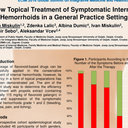All gases entrapped in closed body cavities are destined to be partially or completely absorbed. Intestinal gases often accumulate and cause flatulence. This paper proposes a simple concept of intestinal gas occurrence based on our knowledge on gas resorption in other body cavities. Compliance of intestinal and abdominal walls makes pressure in the liquid chyme bubbles near 760 mmHg. Intestinal gases are from three sources. Air can be swallowed, CO2 come from the gastric acid neutralisation and from intestinal bacterial colonies that also produce hydrogen and methane. In continuously mixed liquid chyme, the total pressure of blood gases is similar or lower than in the venous blood (or=760 mmHg). Some local production of bacterial gases with partial pressure of more than 90 mmHg is required, so the resulting small bowel bubbles would contain less than 20% of bacterial gases. If peristaltic mixing of chyme is prevented by an obstacle, local pressures of bacterial gases build up, form bubbles that fuse and finally make X-ray visible aeroliquid levels. Bacterial gases make almost 3/4 of the flatulence. Formation of bubbles destined to become flatulence might depend on altered rheological condition of the large bowel content, with local abundant production of bacterial gases near bacterial colonies. Gases are unable to diffuse rapidly through the dense liquid content and local accumulation allows formation of bubbles mainly of bacterial gases. Their pressure can be higher 760 mmHg, since they are stretching the thick content. Poor diffusion of gases keeps them almost free of blood gases and their entrance makes them bigger. As the content moves along the colon, the content is becoming more solid and gases are becoming entrapped in large bubbles. Some blood and bacterial gases are absorbed and exhaled, but the remaining quantity has no other escape except flatulence. Flatulence rich in bacterial gases might be the price for the large bowel water reabsorption. It seems that beside the peroral use of antibiotics active in the colon, little can be done to reduce flatulence.



